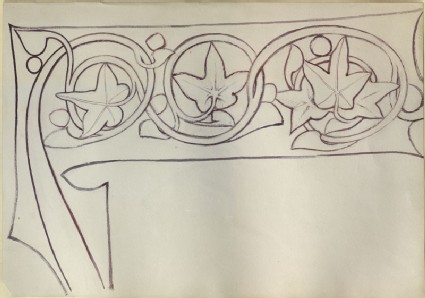Browse: 1470 objects
- Reference URL
Actions
Drawing of an Ivy Branch from the Beaupré Antiphonary anonymous British
-
Details
- Artist/maker
-
anonymous British (Anonymous (British))John Ruskin (1819 - 1900)
- Object type
- drawing
- Material and technique
- watercolour over graphite on wove paper
- Dimensions
- 348 x 493 mm
- Inscription
- Verso, all in graphite:
top centre: 11 C
just below: W.S.II.16.
just above and left of centre: Edu 11- c- Ivy
top right, written down the sheet: Lower School
- Provenance
-
Presented by John Ruskin to the Ruskin Drawing School (University of Oxford), 1875; transferred from the Ruskin Drawing School to the Ashmolean Museum, c.1949.
- No. of items
- 1
- Accession no.
- WA.RS.WS.II.16
-
Subject terms allocated by curators:
Subjects
-
References in which this object is cited include:
References
Taylor, Gerald, ‘John Ruskin: A Catalogue of Drawings by John Ruskin in the Ashmolean Museum, Oxford’, 7 fascicles, 1998, Oxford, Ashmolean Museum, no. 213
Ruskin, John, Catalogue of Examples Arranged for Elementary Study in the University Galleries (Oxford: Clarendon Press, 1870), cat. Educational no. 11.C
Ruskin, John, ‘The Ruskin Art Collection at Oxford: Catalogues, Notes and Instructions’, Edward T. Cook and Alexander Wedderburn, eds, The Works of John Ruskin: Library Edition, 39 (London: George Allen, 1903-1912), 21, cat. Working Series no. II.16
Location
-
- Western Art Print Room
Ruskin's Catalogues
-
Ruskin's Catalogue of Examples (1870)
11 C. Wreath of conventional ivy.From the missal out of which S. 7 is taken . Draw it with the brush, constructing it first as in 11 D. I give you this wreath merely that you may begin to feel what Gothic design means. It is very rude, but interesting, as we shall see afterwards, for some special characters in the transition of styles.





